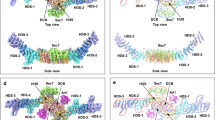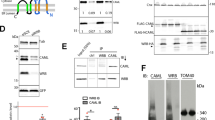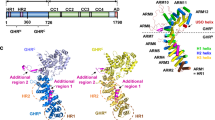Abstract
Transport protein particle (TRAPP) is a large multiprotein complex involved in endoplasmic reticulum–to–Golgi and intra-Golgi traffic. TRAPP specifically and persistently resides on Golgi membranes. Neither the mechanism of the subcellular localization nor the function of any of the individual TRAPP components is known. Here, the crystal structure of mouse Bet3p (bet3), a conserved TRAPP component, reveals a dimeric structure with hydrophobic channels. The channel entrances are located on a putative membrane-interacting surface that is distinctively flat, wide and decorated with positively charged residues. Charge-inversion mutations on the flat surface of the highly conserved yeast Bet3p led to conditional lethality, incorrect localization and membrane trafficking defects. A channel-blocking mutation led to similar defects. These data delineate a molecular mechanism of Golgi-specific targeting and anchoring of Bet3p involving the charged surface and insertion of a Golgi-specific hydrophobic moiety into the channels. This essential subunit could then direct other TRAPP components to the Golgi.
This is a preview of subscription content, access via your institution
Access options
Subscribe to this journal
Receive 12 print issues and online access
$189.00 per year
only $15.75 per issue
Buy this article
- Purchase on Springer Link
- Instant access to full article PDF
Prices may be subject to local taxes which are calculated during checkout





Similar content being viewed by others

References
Guo, W., Sacher, M., Barrowman, J., Ferro-Novick, S. & Novick, P. Protein complexes in transport vesicle targeting. Trends Cell Biol. 10, 251–255 (2000).
Whyte, J.R. & Munro, S. Vesicle tethering complexes in membrane traffic. J. Cell Sci. 115, 2627–2637 (2002).
Lee, M.C.S., Miller, E.A., Goldberg, J., Orci, L. & Schekman, R. Bi-directional protein transport between the ER and Golgi. Annu. Rev. Cell Dev. Biol. 20, 87–123 (2004).
Sacher, M. et al. TRAPP, a highly conserved novel complex on the cis-Golgi that mediates vesicle docking and fusion. EMBO J. 17, 2494–503 (1998).
Sacher, M. et al. TRAPP I implicated in the specificity of tethering in ER-to-Golgi transport. Mol. Cell 7, 433–442 (2001).
Gavin, A.C. et al. Functional organization of the yeast proteome by systematic analysis of protein complexes. Nature 415, 141–147 (2002).
Sacher, M., Barrowman, J., Schieltz, D., Yates, J.R. 3rd & Ferro-Novick, S. Identification and characterization of five new subunits of TRAPP. Eur. J. Cell Biol. 79, 71–80 (2000).
Wang, W., Sacher, M. & Ferro-Novick, S. TRAPP stimulates guanine nucleotide exchange on Ypt1p. J. Cell Biol. 151, 289–296 (2000).
Gedeon, A.K. et al. Identification of the gene (SEDL) causing X-linked spondyloepiphyseal dysplasia tarda. Nat. Genet. 22, 400–404 (1999).
Barrowman, J., Sacher, M. & Ferro-Novick, S. TRAPP stably associates with the Golgi and is required for vesicle docking. EMBO J. 19, 862–869 (2000).
Rossi, G., Kolstad, K., Stone, S., Palluault, F. & Ferro-Novick, S. BET3 encodes a novel hydrophilic protein that acts in conjunction with yeast SNAREs. Mol. Biol. Cell 6, 1769–1780 (1995).
Cole, N.B., Ellenberg, J., Song, J., DiEuliis, D. & Lippincott-Schwartz, J. Retrograde transport of Golgi-localized proteins to the ER. J. Cell Biol. 140, 1–15 (1998).
Munro, S. Organelle identity and the targeting of peripheral membrane proteins. Curr. Opin. Cell Biol. 14, 506–514 (2002).
Lemmon, M.A. Phosphoinositide recognition domains. Traffic 4, 201–213 (2003).
Bijlmakers, M.J. & Marsh, M. The on-off story of protein palmitoylation. Trends Cell Biol. 13, 32–42 (2003).
Liu, J., Hughes, T.E. & Sessa, W.C. The first 35 amino acids and fatty acylation sites determine the molecular targeting of endothelial nitric oxide synthase into the Golgi region of cells: a green fluorescent protein study. J. Cell. Biol. 137, 1525–1535 (1997).
Shenoy-Scaria, A.M., Dietzen, D.J., Kwong, J., Link, D.C. & Lublin, D.M. Cysteine3 of Src family protein tyrosine kinase determines palmitoylation and localization in caveolae. J. Cell Biol. 126, 353–363 (1994).
Murray, D. et al. Electrostatics and the membrane association of Src: theory and experiment. Biochemistry 37, 2145–2159 (1998).
Brennwald, P. & Novick, P. Interactions of three domains distinguishing the Ras-related GTP-binding proteins Ypt1 and Sec4. Nature 362, 560–563 (1993).
Zhou, W. & Resh, M.D. Differential membrane binding of the human immunodeficiency virus type 1 matrix protein. J. Virol. 70, 8540–8548 (1996).
McCabe, J.B. & Berthiaume, L.G. Functional roles for fatty acylated amino-terminal domains in subcellular localization. Mol. Biol. Cell 10, 3771–3786 (1999).
Resh, M.D. Fatty acylation of proteins: new insights into membrane targeting of myristoylated and palmitoylated proteins. Biochim. Biophys. Acta 1451, 1–16 (1999).
Pfeffer, S.R. Rab GTPases: specifying and deciphering organelle identity and function. Trends Cell Biol. 11, 487–491 (2001).
Sivars, U., Aivazian, D. & Pfeffer, S.R. Yip3 catalyses the dissociation of endosomal Rab–GDI complexes. Nature 425, 856–859 (2003).
Uetz, P. et al. A comprehensive analysis of protein-protein interactions in Saccharomyces cerevisiae. Nature 403, 623–627 (2000).
Ito, T. et al. Toward a protein-protein interaction map of the budding yeast: A comprehensive system to examine two-hybrid interactions in all possible combinations between the yeast proteins. Proc. Natl. Acad. Sci. USA 97, 1143–1147 (2000).
Schroder, S., Schimmoller, F., Singer-Kruger, B. & Riezman, H. The Golgi-localization of yeast Emp47p depends on its di-lysine motif but is not affected by the ret1-1 mutation in α-COP. J. Cell Biol. 131, 895–912 (1995).
Otte, S. et al. Erv41p and Erv46p: new components of COPII vesicles involved in transport between the ER and Golgi complex. J. Cell Biol. 152, 503–518 (2001).
Stevens, T., Esmon, B. & Schekman, R. Early stages in the yeast secretory pathway are required for transport of carboxypeptidase Y to the vacuole. Cell 30, 439–448 (1982).
Tholey, A., Pipkorn, R., Bossemeyer, D., Kinzel, V. & Reed, J. Influence of myristoylation, phosphorylation, and deamidation on the structural behavior of the N-terminus of the catalytic subunit of cAMP-dependent protein kinase. Biochemistry 40, 225–231 (2001).
Finger, F.P., Hughes, T.E. & Novick, P. Sec3p is a spatial landmark for polarized secretion in budding yeast. Cell 92, 559–571. (1998).
Rak, A. et al. Structure of Rab GDP-dissociation inhibitor in complex with prenylated YPT1 GTPase. Science 302, 646–650 (2003).
Jang, S.B. et al. Crystal structure of SEDL and its implications for a genetic disease spondyloepiphyseal dysplasia tarda. J. Biol. Chem. 277, 49863–49869 (2002).
Dietrich, L.E., Gurezka, R., Veit, M. & Ungermann, C. The SNARE Ykt6 mediates protein palmitoylation during an early stage of homotypic vacuole fusion. EMBO J. 23, 45–53 (2004).
Terwilliger, T.C. & Berendzen, J. Automated MAD and MIR structure solution. Acta Crystallogr. D 55, 849–861 (1999).
Terwilliger, T.C. Maximum-likelihood density modification. Acta Crystallogr. D 56, 965–972 (2000).
Jones, T.A., Zou, J.Y., Cowan, S.W. & Kjeldgaard, M. Improved methods for binding protein models in electron density maps and the location of errors in these models. Acta Crystallogr. A 47, 110–119 (1991).
Brunger, A.T. et al. Crystallography & NMR system: A new software suite for macromolecular structure determination. Acta Crystallogr. D 54, 905–921 (1998).
Otwinowski, Z. & Minor, W. Processing of X-ray diffraction data collected in oscillation mode. Methods Enzymol. 276, 307–326 (1997).
Collaborative Computational Project, Number 4. The CCP4 suite: programs for protein crystallography. Acta Crystallogr. D 50, 760–763 (1994).
Thompson, J.D., Higgins, D.G. & Gibson, T.J. CLUSTAL W: improving the sensitivity of progressive multiple sequence alignment through sequence weighting, position-specific gap penalties and weight matrix choice. Nucleic Acids Res. 22, 4673–4680 (1994).
Acknowledgements
We are grateful to M. Cygler (Biotechnology Research Institute) for invaluable input and discussions on this work, J. Wagner for technical assistance, and T. Stevens (University of Oregon) and S. Ferro-Novick (Yale University) for providing strains and reagents. This study made use of beamline 6B at Pohang Accelerator Laboratory. This work was supported by Creative Research Initiatives of the Korean Ministry of Science & Technology and by the Réseau Protéomique de Montréal Proteomics Network. Y.-G.K. was supported by the Brain Korea 21 Project.
Author information
Authors and Affiliations
Corresponding authors
Ethics declarations
Competing interests
The authors declare no competing financial interests.
Supplementary information
Supplementary Fig. 1
Enlargement of the electron density for myristoyl-Cys68. (PDF 47 kb)
Supplementary Fig. 2
CD spectra of yeast Bet3p proteins. (PDF 49 kb)
Supplementary Fig. 3
ESI mass spectrum of bet3(8–172) produced in E. coli. (PDF 43 kb)
Supplementary Methods
Supplementary Methods (PDF 13 kb)
Rights and permissions
About this article
Cite this article
Kim, YG., Sohn, E., Seo, J. et al. Crystal structure of bet3 reveals a novel mechanism for Golgi localization of tethering factor TRAPP. Nat Struct Mol Biol 12, 38–45 (2005). https://doi.org/10.1038/nsmb871
Received:
Accepted:
Published:
Issue Date:
DOI: https://doi.org/10.1038/nsmb871
This article is cited by
-
A trapper keeper for TRAPP, its structures and functions
Cellular and Molecular Life Sciences (2012)
-
Characterization of the self-palmitoylation activity of the transport protein particle component Bet3
Cellular and Molecular Life Sciences (2010)
-
The structure of the TRAPP subunit TPC6 suggests a model for a TRAPP subcomplex
EMBO reports (2005)
-
Structure of palmitoylated BET3: insights into TRAPP complex assembly and membrane localization
The EMBO Journal (2005)


